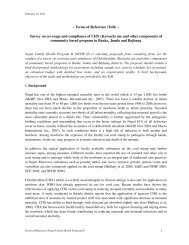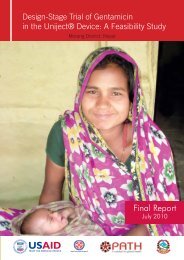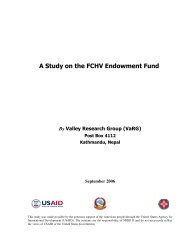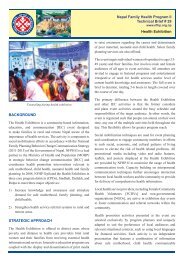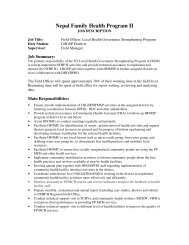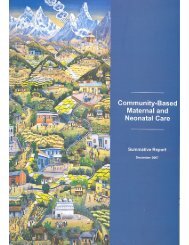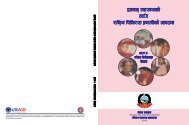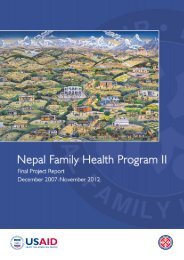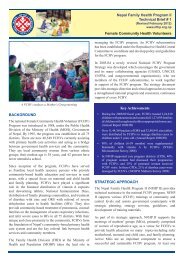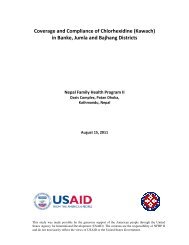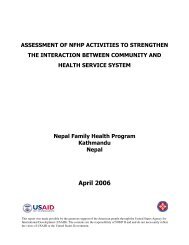(Kawach) in Banke, Jumla and Bajhang Districts - Nepal Family ...
(Kawach) in Banke, Jumla and Bajhang Districts - Nepal Family ...
(Kawach) in Banke, Jumla and Bajhang Districts - Nepal Family ...
You also want an ePaper? Increase the reach of your titles
YUMPU automatically turns print PDFs into web optimized ePapers that Google loves.
Methods of Data Collection <strong>and</strong> Survey Instruments<br />
New ERA reviewed the draft <strong>in</strong>struments developed by NFHP II. There were two sets of<br />
screen<strong>in</strong>g questionnaires <strong>and</strong> a set of structured questionnaire designed for the RDW. The<br />
first screen<strong>in</strong>g questionnaire was adm<strong>in</strong>istered to the head of the household or a<br />
knowledgeable person <strong>in</strong> the household <strong>in</strong> order to determ<strong>in</strong>e the existence of women aged<br />
15-49 years <strong>and</strong> whether or not they were pregnant or had given birth <strong>in</strong> the past two years.<br />
The second set of screen<strong>in</strong>g questionnaire was adm<strong>in</strong>istered to each eligible woman (age 15-<br />
49 yrs <strong>and</strong> had delivered a baby or had pregnancy loss <strong>in</strong> the previous two years) for further<br />
confirmation of her age, date of delivery <strong>and</strong> the number of children she had.<br />
After screen<strong>in</strong>g <strong>and</strong> confirm<strong>in</strong>g the existence <strong>and</strong> availability of RDW (women who had<br />
given live births <strong>in</strong> the preced<strong>in</strong>g year or had a still born after a 28 weeks or more gestation<br />
period) <strong>in</strong> the household, the ma<strong>in</strong> questionnaire was adm<strong>in</strong>istered to her. Though the<br />
<strong>in</strong>formation on coverage <strong>and</strong> compliance of <strong>Kawach</strong> was applicable to RDW with live births<br />
only, RDW with still born were also recruited for the survey <strong>in</strong> order to assess other<br />
component on maternal health <strong>in</strong>clud<strong>in</strong>g awareness on danger signs dur<strong>in</strong>g antenatal, delivery<br />
<strong>and</strong> postpartum periods, coverage of ANC <strong>and</strong> PNC services, birth preparedness practice <strong>and</strong><br />
complications read<strong>in</strong>ess.<br />
In the case of more than one eligible RDW <strong>in</strong> a household, one RDW was selected r<strong>and</strong>omly.<br />
The ma<strong>in</strong> household questionnaire <strong>in</strong>cluded the background characteristics of the respondents<br />
as well as their knowledge, attitude on <strong>and</strong> practice of various aspects of maternal <strong>and</strong><br />
neonatal health, coverage <strong>and</strong> compliance of <strong>Kawach</strong>, level of acceptance <strong>and</strong> perception on<br />
<strong>Kawach</strong> use <strong>and</strong> other <strong>in</strong>formation directly related to the study objectives.<br />
Field-test of the Survey Instruments<br />
In order to familiarize the field enumerator with the survey procedures <strong>and</strong> to identify the<br />
necessary changes required to the survey <strong>in</strong>struments, a pre test was done <strong>in</strong> Alau VDC of the<br />
Parsa district, where Plan <strong>Nepal</strong> was implement<strong>in</strong>g the CHX pilot study along with community<br />
based newborn care program. The pre-test assisted <strong>in</strong> improv<strong>in</strong>g the field procedures <strong>and</strong><br />
familiarized the rest of the team member with potential survey cases. Based on pre-test, the<br />
questionnaires were aga<strong>in</strong> reviewed <strong>and</strong> modified. Also, experiences were shared amongst all<br />
team members so that the necessary <strong>in</strong>formation could be collected <strong>in</strong> an efficient manner.<br />
Implementation of Survey<br />
Field Survey Team Selection<br />
The household data collection for the study was carried out by 11 field supervisors <strong>and</strong> 24<br />
enumerators. There were a total of 11 teams of 12 males <strong>and</strong> 23 females. Each team consisted of<br />
one supervisor <strong>and</strong> two to three enumerators depend<strong>in</strong>g on the geographical constra<strong>in</strong>ts of the<br />
districts. All the field staffs were selected from the pool of New ERA field researchers who<br />
have already worked on other similar surveys. The essential requirement for select<strong>in</strong>g field<br />
staff was that they possess relevant work experience <strong>in</strong> a similar area, work experience <strong>in</strong> rural<br />
communities, academic qualifications, languages known/spoken, <strong>and</strong> rapport-build<strong>in</strong>g<br />
capacities.<br />
5



